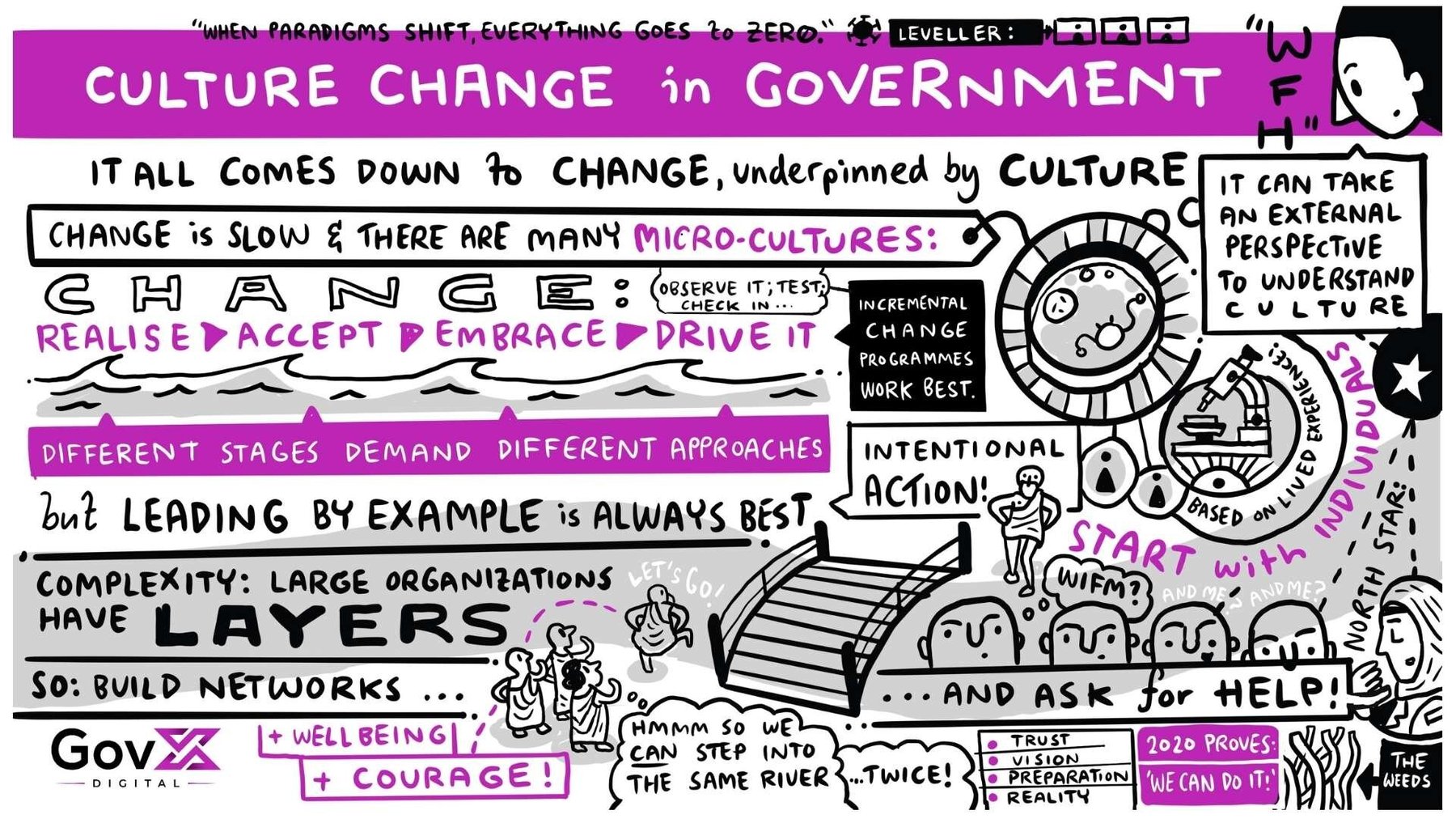How to make culture change happen in Government
Changing culture presents a diverse set of challenges across public sector organisations, so how do we make it happen and bring our people with us on the journey? These are the key takeaways from our panel of public sector leaders who came together for our session on ‘Culture Change’.

Marco Salzedo - Director of Commercial & Contract Management Capability, Cabinet Office
When talking about change, and even more importantly culture, it’s critical to consider what’s in it for the individual. Often there's a trap that once the change is explained, the “why we’re making the change” narrative is forgotten.
It's important that the narrative is clear around what is there for the individual. We focus heavily on that during our change programmes in the Commercial space. What is going to be different as a result of the change - for the individual, for teams, and then more generally for the profession?
As we transition people through the change programme in the Government Commercial Function, we actually do ‘what's in it for them’ documents, sitting down to create a personalised document that explains what's going to be different. “This is what we will offer you from a capability uplift perspective, but this is also what we need from you as well.”
Sometimes there’s a risk that we set a narrative in the centre, but as it percolates all the way through the organisation to the people who’re at the sharp end doing the work, that narrative is completely different. Fine tuning it and honing it for different groups, individuals and parts of the organisation is key.
Lynda Rawsthorne - Director Programme Integration at Department for Transport
You don't always have time, but my advice would be that if you do have time, don’t rush, but take time to understand the change curve. I remember the first time someone took me through the model of the change curve - it was honestly like a light going on.
Previously, I would put a change in place and then two weeks later, think it hadn’t worked so I’d put another change in place.Then it reached a point where some things were improving, but then when I looked at it, because I'd made so many changes, I couldn't do the cause and effect. When you're passionate about making something better, it is so easy to just go at it.
When people say it's a marathon, not a sprint, that really is the truth, and that links to wellbeing, and the fact that you can't just exhaust yourself at any point.
If you can, consult with those who have influence, and when I say influence, I don't mean hierarchical power. I asked a colleague recently: “How do you know who has influence?”
Their view was that when things go out on the internet, you can see who's looked at them, you can see who's commented on them. Sometimes there are people that you would never find just by looking at organisational charts, but those are the people who get stuck in and those will be the people who are connected. If you can get them on board you know you're going in the right direction.
Bernadette Thompson - Deputy Director, Inclusion, Wellbeing & Employee Engagement, Ministry of Housing, Communities and Local Government
This is about intentional action and it's really important that the leaders set the tone. When we do our people survey, it’s about people's real-time, lived experiences of the culture within their department and, more broadly, the culture of the Civil Service.
We need to understand those experiences across different characteristics, because they're different nuances from a diversity point of view. The difference that we make to people's lives is driven by the senior leadership really listening to the lived experiences.
Ask people in different places in the organisation to continue the sentence: “This is a place where...”. What are people going to say at the end? Is this a place where people at a particular grade feel they're being left out? It’s about really getting to the bottom of some of that quantitative analysis.
But intentional action is what creates the difference and helps us to create culture change. For example, if we think about flexible working, there has been intentional action around that agenda, looking at the technology, how we can work remotely, what we can do to ensure people are able to work from different places. Action is what helps us to make a difference with culture.
Manisha Pathak - META Programme Lead, Future Leaders Scheme, Civil Service Talent, Cabinet Office
What we've done in the accelerated development schemes and the Future Leaders scheme is quickly move into the virtual space to keep engaged with our senior leaders. The experience of 2020 has proven that the Civil Service machinery is able to work remotely, and to continue engagement with teams and departments.
It's a risk we took and everyone leaned into it, which was a powerful moment for us. The team and I were able to create safe virtual spaces for not only the META family, but also across the accelerated development schemes, where we were able to collectively share our leadership journey and continue the curriculum.
One of the difficulties we’ve faced in the virtual space is sometimes picking up on the nonverbal cues that you’d have in a face-to-face environment. How do you create that in the virtual space while being mindful that you don't want to create virtual fatigue?
We can mitigate some of those challenges through upbeat power check-in sessions, so we can engage with not only our teams and the people that we lead, but also the leaders that are on our schemes as well. We’re mindful of those nonverbal cues we so heavily rely on as leaders - those coffee moment talks, those coming out of a meeting chats, those moments of interaction where you can dissolve some issue that may have arisen.
Becky Thoseby - Head of Workplace Wellbeing, Ministry of Justice
It's really important to have that strong and compelling narrative about the change you're trying to affect, and be able to withstand challenges to that. The change that I'm bringing about is a move towards a person-centered approach to wellbeing. I've talked to people about this so many times now that there's very little that people can ask about it or do to challenge it that surprises me.
Consistency is key. If people are going to come around to your way of thinking, it needs to be very clear to them. And it needs to be repeated in that same way, consistently.
We also want to help others recognise their own courage, because culture change is tough. It's sometimes controversial, you're going to encounter resistance, especially in a field as new as wellbeing, where there isn’t an established right way of doing things. So sometimes you're going to need to be brave. Sometimes you're going to have to do it at such a quick pace, that you're not going to have time to summon your courage, but recognising your own bravery is going to give you the strength and pride you need to continue.
Liz McKeown - Lecturer, Digital Academy, Canada School of Public Service
The same obstacle comes up over and over again, no matter what environment I'm in, and that obstacle is weeds - people have the desire to get into the weeds - the detail - at the wrong time.
Among the ways that I try to overcome them is number one, making sure that everybody knows what that Northstar is. What is it that we're all trying to do here? What are we going to look like as we're affecting this change? What are we going to look like when we're further down that path?
Secondly, is that “what's in it for me?” that others have mentioned. People need to be able to personalise that change. It’'s at that moment when people decide if they're going to drive that change, or they're going to follow along, or they're going to walk away from it, or even actively work against it.
The third one is everybody needs to have an understanding of how they're going to be a part of that change. As leaders, we have to connect this with the organisation's performance objectives and whatever performance management regime you have.
People have to understand what they do on a daily basis, and how that connects with that Northstar. If you can't see what you do, no matter what part of the organisation you're in, and how it leads to that Northstar, then you need to have a discussion with your manager because you're not aligned. And maybe it means that you need to move to another organisation, which is sometimes the right thing to do.






